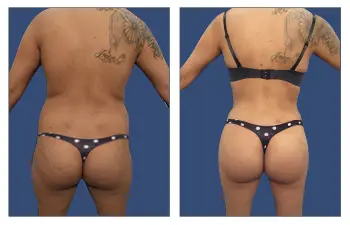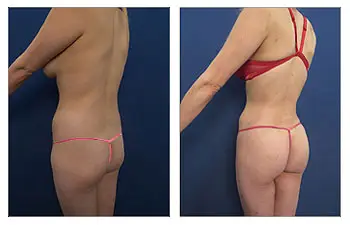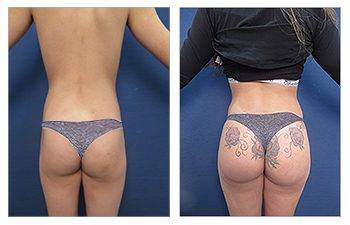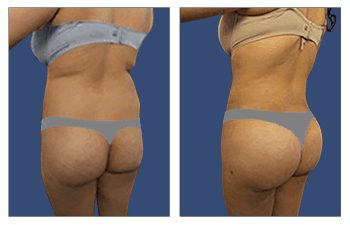Introduction to BBL Meaning
The BBL, also known as the Brazilian Butt Lift, is an aesthetic enhancement procedure that has gained significant popularity in recent years. This procedure involves removing fat from one area of the body and transferring it to the buttocks in order to enhance their shape and size. BBL meaning describes a procedure that is designed to give patients more defined curves and an overall more balanced and aesthetically pleasing appearance.
The Brazilian Butt Lift procedure has various aspects that need to be considered. Firstly, there are different techniques and procedures involved in performing the surgery, such as liposuction to harvest fat from areas like the abdomen, thighs, or back, and then transferring that fat to the buttocks through injections. Secondly, like any surgical procedure, there are risks associated with BBL, such as infection, bleeding, and asymmetry. It is important to thoroughly discuss these potential risks with a board-certified plastic surgeon before undergoing the procedure.
The cost of a Brazilian Butt Lift can vary depending on factors such as the surgeon’s expertise, the geographic location of the practice, and the extent of the procedure. It is important to consider this cost as part of the overall budget for aesthetic enhancements.
When considering a Brazilian Butt Lift, it is crucial to choose a board-certified plastic surgeon who specializes in this procedure. Board certification ensures that the surgeon has met rigorous standards of education and training, making them highly qualified to perform the procedure safely and effectively.
Why People Get a BBL (Brazilian Butt Lift)?
People choose to get a Brazilian Butt Lift (BBL) for various reasons. Motivations for this procedure often include a desire to enhance their physical appearance and achieve a more curvaceous figure. Many individuals seek a rounder, fuller buttocks to enhance their self-confidence and improve their overall body proportions.
The desired outcome of a BBL is a more prominent, lifted, and shapelier buttocks. By removing excess fat from other areas of the body through liposuction, such as the abdomen, hips, or thighs, and injecting that fat into the buttocks, patients can achieve a more youthful and toned appearance. This procedure can help create a more hourglass-like figure and improve overall body symmetry.
The advantages of a BBL go beyond aesthetic results. Patients benefit from the fact that the procedure uses their body’s own fat, making it a natural and safe way to augment their buttocks. Additionally, liposuction performed during the procedure helps contour and sculpt other areas, resulting in a more proportionate physique.
However, it is essential to consider the potential risks and complications associated with BBL surgery. One significant risk is fat embolism, where fat enters the bloodstream and may travel to other parts of the body, causing serious complications. Infection, scarring, asymmetry, and changes in skin sensation are other potential risks.
Being a good candidate for a BBL requires good overall health and realistic expectations. Candidates should have enough fat available for harvesting through liposuction and be willing to follow post-surgery instructions, including avoiding sitting or lying directly on their buttocks for an extended period.
How Common Are BBL (Brazilian Butt Lift)?
The Brazilian Butt Lift (BBL) has gained significant popularity in recent years, with a growing number of individuals seeking to enhance the shape and volume of their buttocks. In the United States, the prevalence of BBLs has shown a steady upward trend. According to statistics from the American Society of Plastic Surgeons, there were approximately 20,301 BBL procedures performed in 2018, which increased to 28,349 in 2019. In Florida, in particular, there has been a notable surge in the demand for BBLs. In 2019, Florida accounted for the highest number of BBLs in the country, with around 4,487 procedures.
However, the number of BBLs experienced fluctuations, primarily due to the impact of the COVID-19 pandemic. The outbreak of the pandemic resulted in the temporary closure of many plastic surgery clinics, leading to a decline in BBL procedures. Additionally, the fear of contracting the virus and financial uncertainties caused some individuals to postpone or cancel their plans for undergoing plastic surgery, including BBLs.
In terms of overall butt augmentations, including both BBLs and implants, it has been observed that there has been a continuous increase in recent years. In 2021, the total number of butt augmentations is projected to reach a record figure of around 36,000 procedures. This represents a significant growth from the previous year, with a percentage increase of approximately 20%.
Who Can Get a BBL (Brazilian Butt Lift)?
Criteria: Good Health, Excess Fat, Desire for larger and rounder buttocks, and Ability to avoid sitting/sleeping on butt.
To determine who is eligible for a BBL (Brazilian Butt Lift), there are specific criteria that individuals must meet. Firstly, good overall health is vital to undergo this procedure successfully. A comprehensive medical evaluation will be conducted to ensure there are no underlying health conditions that could complicate the surgery or recovery process.
Another important factor is the availability of excess fat for transfer. During a BBL, fat is harvested from other areas of the body, such as the abdomen, thighs, or hips, and then strategically injected into the buttocks to enhance their shape and size. Therefore, individuals seeking a BBL must have enough excess fat in these donor areas for a successful transfer.
Furthermore, the desire for larger and rounder buttocks is a key criterion for undergoing a BBL. Many individuals may feel dissatisfied with the shape or size of their buttocks and wish to achieve a more aesthetically pleasing appearance. The BBL procedure can help them achieve this goal by enhancing the curves and proportions of their buttocks.
Lastly, it is crucial for individuals considering a BBL to understand and commit to the post-operative care instructions. After the surgery, patients must avoid sitting or sleeping directly on their buttocks for several weeks. This is to ensure that the newly transplanted fat cells have the best chance of survival and integration into the existing buttock tissue.
In summary, to be an ideal candidate for a BBL, individuals must possess good overall health, have enough excess fat for transfer, desire larger and rounder buttocks, and be committed to following the instructions regarding sitting and sleeping after the surgery. These criteria ensure the best possible outcomes and minimize the risk of complications for individuals undergoing a BBL procedure.
What Happens During a BBL (Brazilian Butt Lift)?
During a Brazilian Butt Lift (BBL) surgery, several steps are involved to enhance the shape and size of the buttocks. The procedure typically requires the use of anesthesia and involves liposuction, fat purification, fat injection into the buttocks, and wound closure.
The first step is administering anesthesia to ensure the patient’s comfort throughout the surgery. This can be a combination of intravenous sedation and local anesthesia or general anesthesia, depending on the patient’s needs and the surgeon’s preference.
The next step is liposuction, where excess fat is removed from specific areas of the body, such as the abdomen, thighs, or flanks. The fat is carefully collected using a suctioning device, ensuring minimal trauma to the surrounding tissues.
Once the fat is extracted, it undergoes a purification process. This involves separating the healthy fat cells from impurities and fluids. The purified fat is then prepared for injection.
The purified fat is strategically injected into the buttocks using small, specialized cannulas. The fat is injected in layers to create a fuller and more well-defined shape, tailored to the patient’s desired outcome.
After the fat injection, the incisions created for liposuction are carefully closed using sutures or adhesive tape. Dressings or compression garments may be applied to aid in the healing process.
Although Brazilian Butt Lift surgeries are generally safe, there are potential risks and complications associated with the procedure. These may include infection, bleeding, scarring, asymmetry, fat embolism, and skin contour irregularities. It is essential to discuss these risks with a qualified and experienced surgeon and to follow all pre- and post-operative instructions to minimize the chances of complications.
What is recovery like for a BBL (Brazilian Butt Lift)?
Recovering from a Brazilian Butt Lift (BBL) involves several stages, each with its own set of activities and restrictions. It is crucial to follow these guidelines to ensure optimal results and minimize complications.
During the initial stage of recovery, which typically lasts for about two weeks, it is important to avoid pressure on the grafted fat areas. Sitting or lying directly on the buttocks can negatively affect the fat transfer process. Instead, individuals are advised to sleep on their stomach or sides. This position helps maintain the newly transferred fat and aids in its integration with the surrounding tissues.
In terms of activities, patients are encouraged to engage in light movements and walking to promote blood circulation. However, strenuous activities and exercises should be avoided during this stage to prevent excessive swelling or damage to the grafts.
The second stage of recovery occurs from week three to week eight. During this period, patients can gradually increase their activity level but still need to be cautious. Sitting for long periods should still be avoided, and if necessary, individuals must use a cushion or pillow to support their thighs rather than their buttocks. Additionally, avoiding direct pressure on the grafts when getting up or down is crucial.
By week eight, most patients can resume normal daily activities, including sitting for short periods. However, it is essential to continue using pillows or cushions to protect the transferred fat. Patients can gradually reintroduce exercise but should still avoid activities that target the buttocks directly.
Recovery from a BBL is a gradual process that requires patience and adherence to the designated stages. By avoiding pressure on grafted fat areas and sleeping on the stomach, individuals can maximize their chances of achieving a more desired outcome. Remember to follow the recommended activities and restrictions for each stage to facilitate optimal healing and long-lasting results.
What is the cost of BBL (Brazilian Butt Lift)?
The cost of a Brazilian Butt Lift (BBL) can vary depending on several factors. One primary factor is the geographical location where the procedure is performed. Prices tend to be higher in major metropolitan areas compared to smaller cities or towns. Additionally, the experience and reputation of the plastic surgeon can influence the cost. Highly skilled and experienced surgeons may charge more for their expertise.
Another factor influencing the cost of a BBL is the complexity of the procedure. If a patient requires additional procedures, such as liposuction to harvest fat for the BBL, the overall cost will be higher. The amount of fat that needs to be transferred and the desired outcome also affect the pricing.
In addition to the base cost, there are often additional fees associated with a BBL. These may include anesthesia fees, facility fees, pre-operative tests, post-operative garments, and follow-up appointments. It is crucial for patients to inquire about these fees during their consultation to have an accurate understanding of the total cost.
Lastly, the surgeon’s reputation and demand for their services can significantly impact prices. Renowned surgeons with high demand may charge a premium for their skills and experience. On the other hand, less experienced or newly-established surgeons may offer lower prices to attract clientele.
What are the complications of a BBL (Brazilian Butt Lift)?
The Brazilian Butt Lift (BBL) surgery is a popular cosmetic procedure that aims to enhance the shape and size of the buttocks by transferring fat from other parts of the body. While it can provide highly satisfying results, there are several potential complications that patients should be aware of.
One of the most serious risks associated with BBL surgery is fat embolization, where fat enters the bloodstream and travels to the lungs or other organs. This can lead to life-threatening complications such as respiratory distress. Infection is also a concern, as the surgery involves the transfer of fat from one area of the body to another, increasing the risk of bacterial contamination.
Changes to skin sensation can occur following BBL surgery, such as numbness or altered sensitivity in the treated areas. Additionally, loose skin may be a concern, especially if significant amounts of fat are removed from one area and transferred to the buttocks. Scarring is another possible complication, although skilled surgeons strive to minimize visible scars.
Bruising, swelling, and skin discoloration are common after any surgical procedure, including BBL surgery. However, proper post-operative care and adherence to surgical instructions can help mitigate these temporary complications.
Compared to other cosmetic surgeries, BBLs have an increased risk of fat embolization due to the injection technique. Injecting fat tissue below the gluteal muscle can inadvertently introduce fat into blood vessels, potentially causing embolization. Hence, it is vital for surgeons to inject the fat above the muscle to avoid this severe complication.
Butt implants vs BBL (Brazilian Butt Lift)
Butt implants and Brazilian Butt Lift (BBL) are two popular procedures aimed at enhancing the shape and size of the buttocks. While they both provide similar outcomes, there are key differences between the two.
Butt implants involve the surgical insertion of silicone implants into the buttocks to increase volume and improve shape. On the other hand, BBL is a natural fat transfer procedure where fat is extracted from other areas of the body, such as the abdomen or thighs, and then injected into the buttocks for augmentation.
When considering butt implants, there are certain risks and advantages to be aware of. The risk of capsular contracture, where scar tissue forms around the implant and causes firmness and distortion, is a possibility. Additionally, there is a risk of infection, as with any surgical procedure. However, the advantages of butt implants include a more predictable and permanent result compared to BBL. Implants provide a consistent shape and volume, and the procedure is less invasive and requires a shorter recovery time.
BBL, on the other hand, comes with its own set of risks and advantages. One of the potential complications is fat embolization, where fat cells enter the bloodstream and can potentially cause blockages in blood vessels. However, the advantage of BBL is that it provides a more natural result, as the fat is derived from the patient’s own body. The procedure also allows for further body contouring through liposuction in the donor areas.
How to Choose a Surgeon for a BBL (Brazilian Butt Lift)
Choosing the right surgeon for a Brazilian Butt Lift (BBL) is a crucial step in ensuring a safe and successful procedure. Several factors should be considered when making this decision.
First and foremost, the surgeon’s credentials play a vital role. It is essential to research the surgeon’s certifications and memberships in reputable medical organizations. Look for surgeons who are board-certified by recognized plastic surgery boards, as this indicates they have met stringent requirements and have demonstrated their expertise in the field.
A surgeon’s training and specialization in BBL procedures are also important considerations. BBL is a complex surgery that requires specific skills and knowledge. It is advisable to choose a surgeon who has undergone focused training in BBL techniques and has significant experience in performing this specific procedure.
In addition to credentials and training, the surgeon’s track record and patient testimonials should be carefully evaluated. Look for before and after photos of BBL procedures performed by the surgeon to assess the quality of their work and the consistency of their results.
When discussing the procedure with a potential surgeon, they should be able to outline the safety measures they will implement to minimize risks during surgery. This may include the use of advanced techniques, such as the use of a fat transfer instead of implants, which reduces the chances of complications. The surgeon should also discuss pre-operative preparation, anesthesia choices, and post-operative care instructions.
Conclusion: BBL Meaning
In conclusion, BBL stands for Brazilian Butt Lift, which is an aesthetic enhancement procedure to reshape and enhance the buttocks. The cultural associations surrounding BBL vary, with some viewing it as a symbol of beauty and desirability, while others criticize it as promoting unrealistic body standards.
The main purpose of a Brazilian Butt Lift is to create a more prominent and desirable buttock contour. This is achieved by removing excess fat from other areas of the body through liposuction and transferring it to the buttocks. The procedure has gained popularity in recent years, with many notable figures in the entertainment industry openly discussing or undergoing the procedure.
The technique used in a Brazilian Butt Lift involves skilled liposuction to extract fat from areas such as the abdomen, thighs, or back. The fat is then carefully processed and injected into the buttocks to create a natural and fuller shape.
It is important to note that BBL has had its fair share of controversies due to associated risks and complications. Patients must carefully choose an experienced and qualifkied surgeon to minimize the risks and ensure optimal results.



























